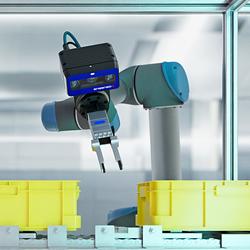Energid Technologies Contracted to Control and Simulate a Multi-Arm Robot for Assembling Satellites
Advanced Software Selected to Enable Robotic Assembly in Orbit for the DARPA Phoenix Program
Cambridge, Massachusetts (December 5, 2013) - Energid Technologies
control and simulation to DARPA's Phoenix program. Phoenix seeks to leverage
Energid's software to redefine how satellites can be built and maintained through
assembly and repair in orbit.
For half a century the essence of building and launching a satellite has
stubbornly endured. A commercial satellite today is built on the ground, launched
alone, and abandoned upon failure. The revolutionary DARPA Phoenix program
is leveraging new engineering technologies with the goal of improving and
transforming this process.
"As envisioned, future satellites will be assembled in space, fill launch vehicles to
their fullest, and be recycled when they break," said Neil Tardella, Energid's
CEO.
Energid has been selected to provide its Actin software as an enabling
technology. Actin supports control of multiple arms, each having extra motions,
like human arms that can raise and lower elbows independently of hand
movement to work cooperatively. With Actin, robots are able to gain larger
workspaces, improved accuracy, and the ability to reach around obstacles.
Applied to a Phoenix mission, Actin would be used to take advantage of these
extra motions on robots operating in geosynchronous orbit, 22,000 miles above
the Earth.
Actin manages constraints and optimizations. This allows a robot operator to
focus only on how a tool or gripper should move and have the joints
automatically take action to achieve that motion in the best way-avoiding
collisions and joint limits and optimizing for accuracy and strength.
Actin is able to simulate the Phoenix system before launch and before missions
to improve the hardware design and refine objectives. Actin's robot simulation
software models the physics of robot motion and the interaction with the
environment. It enables prediction of success and corrections of problems using
only a digital model.
"Greater involvement with the Phoenix program is a wonderful event for our
company," said James English, the CTO of Energid. "The technology is thrilling,
and we are honored by the trust placed in us when there is so much at stake."
In this effort, Energid is leveraging technology developed for NASA, the National
Science Foundation, and the Naval Research Laboratory. Energid's work on the
project will be done in Massachusetts, Illinois, Texas, and Arizona.
For additional information, contact Mary Salzman, (888) 547-4100 x 420.
About Energid Technologies
Energid Technologies develops robotic systems and products for the aerospace,
agriculture, transportation, manufacturing, defense, and medical industries.
Energid's ActinTM and SelectinTM products provide advanced technology in the
form of extensible software toolkits. Energid specializes in control, simulation,
sensing, and communications for complex systems.
© 2013 Energid Technologies Corporation. All rights reserved. Actin, Selectin,
and the Energid logo are trademarks of Energid Technologies Corporation.
Featured Product

3D Vision: Ensenso B now also available as a mono version!
This compact 3D camera series combines a very short working distance, a large field of view and a high depth of field - perfect for bin picking applications. With its ability to capture multiple objects over a large area, it can help robots empty containers more efficiently. Now available from IDS Imaging Development Systems. In the color version of the Ensenso B, the stereo system is equipped with two RGB image sensors. This saves additional sensors and reduces installation space and hardware costs. Now, you can also choose your model to be equipped with two 5 MP mono sensors, achieving impressively high spatial precision. With enhanced sharpness and accuracy, you can tackle applications where absolute precision is essential. The great strength of the Ensenso B lies in the very precise detection of objects at close range. It offers a wide field of view and an impressively high depth of field. This means that the area in which an object is in focus is unusually large. At a distance of 30 centimetres between the camera and the object, the Z-accuracy is approx. 0.1 millimetres. The maximum working distance is 2 meters. This 3D camera series complies with protection class IP65/67 and is ideal for use in industrial environments.
